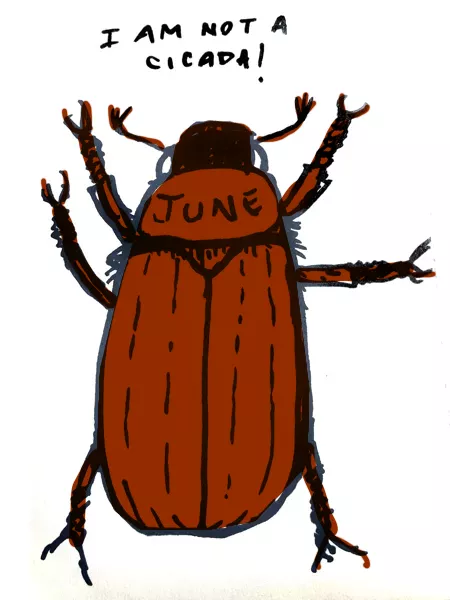By John M. Okinson
Long time ago, in midsummer, when Lalu (the cicada) began to sing, the old women among the Indians used to go our to the fields with their baskets to gather green beans. And while they were away in the fields one of the old men would gather the little children and promise to tell them of how the cicada brought the beans to the people if the little ones would only keep quiet until their mothers and their grandmother got back and had put some beans to cook in the pot.
So white the little ones listened, the old man would tell them this story:
It was at the time the animals got so crowded in Galun-lati (the world above the arch of the sky) that they sent the tiny water beetle down to the world below to find some earth. And after the water beetle had gone own to the bottom of the water which covered all the earth at that time and had brought up a bit of mud, and after this bit of mud had grown to be the earth as we know it now, the animals all came down from Galun-lati.
Now, they were in such a hurry to get down to this earth, which they could see by looking over the edge of the world above, that it was hard for the great beaver, who was chief of the animal people, to make them remember to take food with them. Over and over the great beaver had to tell the animals that they had to take seed to plant on the new earth, as well as food to last them until the seed had had time to grow.
It was springtime when the earth got hard enough for the animals to live on; and then they came down, hand over hand, by way of the four cords which had been let down to hold the earth from the four corners of the world above. Every animal had on his back a pack which held food and seed for planting.
Now, the rabbit was the fellow who ought to have brought down the bag of beans for seed. But when he came to the edge of the world above and looked down, he was afraid that if he strapped a pack on his back, he would not be able to stick to the cord and come safely down to the earth. So when no one was looking, he took off the pack and threw it in a pile of brush.
And when the great beaver asked the rabbit for the seed beans to plant, the rabbit looked very sad and said that the strap on his pack had come loose and the pack had fallen before he was half way down. They all began to look for it, but it was not to be found!
And so the animals planted their corn and their tobacco, and their greens and their nut trees and their goobers and their potatoes. But they had no beans! And then they began to build their houses while they were waiting for everything to grow.
The animals did not know it, but they left behind the cicada. He had gone to sleep months before, when the winter was coming on; and it was not until midsummer, long after the others had gone down, that Lalu woke in Galun-lati and found himself alone.
And when the cicada had found that all the others had gone, he went all around the edge of the world above to find out where they had gone. And he came to the pile of brush into which the rabbit had thrown the beans for seed, and he found that the beans had been spilled out of the pack and were growing.
So, the cicada, being very hungry, cooked some of the green beans and sat down and began to eat them, though he knew that everybody had always waited for them to grow ripe and hard. And they were good! As he ate, he heard a noise down below. It was the animals in council, and they were talking about what they would have to eat next winter.
The cicada heard some of the talk and he leaned over and shouted:
“You must try some of these green beans!” And he threw down a handful. The animals tried them, and they were good! Then they told the cicada how to get down.
And now, whenever the cicada begins to sing, after waking from his long sleep, the people know that the green beans are ready to eat.







